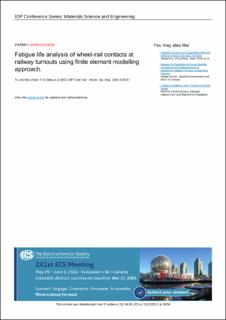| dc.contributor.author | Jelila, Yohanis D. | |
| dc.contributor.author | Lemu, Hirpa G. | |
| dc.contributor.author | pamula, Wiesław | |
| dc.contributor.author | Sirata, Goftila | |
| dc.date.accessioned | 2021-12-14T13:37:01Z | |
| dc.date.available | 2021-12-14T13:37:01Z | |
| dc.date.created | 2021-12-12T15:17:19Z | |
| dc.date.issued | 2021 | |
| dc.identifier.citation | Jelila, Y.D., Lemu, H.G., Pamula, W., Sirata, G.G. (2021) Fatigue life analysis of wheel-rail contacts at railway turnouts using finite element modelling approach. IOP Conference Series: Materials Science and Engineering, 1201, 012047 | en_US |
| dc.identifier.issn | 1757-8981 | |
| dc.identifier.uri | https://hdl.handle.net/11250/2834227 | |
| dc.description.abstract | The article deals with wheel-rail contact analysis at railway turnout using a finite element modelling approach. The focus is understanding the wheel-rail contact problems and finding the means of reducing these problems at railway turnouts. The main aim of the work reported in this article is to analyse fatigue life and simulate the wheel-rail contact problems for a repeated wheel loading cycle by considering the effect of normal and tangential contact force impact under different vehicle loading conditions. The study investigates the impact of tangential contact force generated due to different-angled shapes of the turnout and aims to reveal how it affects the life of contacting surfaces. The obtained results show that the maximum von-Mises equivalent alternating stress, maximal fatigue sensitivity, and maximum hysteresis loop stresses were observed under tangential contact force. These maximum stresses and hysteresis loops are responsible for rolling contact fatigue damage, and excessive deformation of the wheel-rail contact surface. At a constant rotational velocity, the tangential contact force has a significant impact on the fatigue life cycle and wheel-rail material subjected to fatigue damage at lower cycles compared to the normal contact force. The finite element modelling analysis result indicated that the contact damages and structural integrity of the wheel-rail contact surface are highly dependent on contact force type and can be affected by the track geometry parameters. | en_US |
| dc.language.iso | eng | en_US |
| dc.publisher | IOP Publishing | en_US |
| dc.rights | Navngivelse 4.0 Internasjonal | * |
| dc.rights.uri | http://creativecommons.org/licenses/by/4.0/deed.no | * |
| dc.subject | teknologi | en_US |
| dc.subject | fatigue | en_US |
| dc.title | Fatigue life analysis of wheel-rail contacts at railway turnouts using finite element modelling approach | en_US |
| dc.type | Peer reviewed | en_US |
| dc.type | Journal article | en_US |
| dc.description.version | publishedVersion | en_US |
| dc.subject.nsi | VDP::Teknologi: 500 | en_US |
| dc.source.volume | 1201 | en_US |
| dc.source.journal | IOP Conference Series: Materials Science and Engineering | en_US |
| dc.identifier.doi | 10.1088/1757-899X/1201/1/012047 | |
| dc.identifier.cristin | 1967430 | |
| dc.source.articlenumber | 012047 | en_US |
| cristin.ispublished | true | |
| cristin.fulltext | original | |
| cristin.qualitycode | 1 | |

